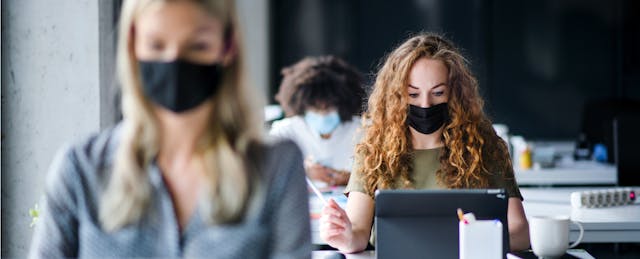Listen to this week’s EdSurge Podcast episode on Apple Podcasts, Overcast, Spotify, Stitcher, Google Play Music, or wherever you listen to podcasts, or use the player on this page. Below are lightly edited highlights from the conversation.
Some colleges were committed to doing as much in-person teaching and activities as possible this semester, even during this health crisis. While other colleges decided early on to focus attention online and pretty much shutter campus for now. So which decision was the right one for students and professors?
That’s the guiding question of the final episode of our Pandemic Campus Diaries podcast series. The goal of the project has been to capture what college life is like during this time—to hear some key challenges and find out how people are getting through them.
Purdue University became a kind of poster child for keeping campus open. Purdue’s president, former Indiana governor Mitch Daniels, spent the summer selling its reopening plan—going on CNN and doing other media interviews touting the miles of plexiglass barriers that Purdue was installing and other measures of the so-called Protect Purdue initiative. Protect Purdue was a kind of brand, hyped on campus to try to sell this idea that Purdue students and professors are special, and that they can engineer their way through this pandemic and still get their education.
Joseph Ching, a junior at Purdue, started out excited to have this campus experience, but he very quickly realized that even though he was living on campus, most of his classes were online. Most of the professors in the classes that he signed up for had opted to teach remotely.
In a typical semester before COVID, Joseph figures he sat in classrooms learning for about 15 to 18 hours per week. This semester, he typically spent about an hour and a half in a physical classroom. But professors expected students to log an equivalent amount of hours watching lecture videos they recorded on YouTube, or in Zoom meetings. In reality, Joseph found it hard to watch hour-long lecture videos, even when he sped them up using the 2x feature that makes voices sound a bit like chipmunks.
Meanwhile, Deb Nichols, a professor at Purdue, had a similar experience, but in reverse. She showed up in person to teach her classes early in the term, and the students all chose to be online instead and watch via Zoom. In some cases, that was because some were sick or in quarantine because they had been exposed to someone who had COVID-19. “At that point I moved everything to online synchronous learning,” she says.
Another campus that pushed to go back in person was Texas State University. But plenty of professors there put in requests to their deans that they teach online as well, and that was the case for Rachel Davenport, a senior lecturer in biology. She has won several awards for her teaching, both online and in person, but she thought things would be smoother for everyone this term as online only.
“We fell behind on the material in all of my classes,” she says. “I didn't get to cover an entire chapter and a half” in one class, and that “they didn't get as much as they signed up for.” But she says student engagement with the material was high, and grades were higher than usual as well.
Does she think the university did the right thing by trying to stay open?
“When people are saying like, well, we only had X number of cases and nobody at Texas State has died yet, which doesn't seem like quite the right measure,” she says. “I can't help but feel like we were playing Russian roulette. You don't play Russian roulette and then if the bullet isn't in the chamber when you pull the trigger, you don't say, 'Oh, I was right to play this.' It was still a terrible idea. You just got really lucky. So I personally think staying open put a lot of people at risk and put a lot of faculty in a position of having to do way more work than they needed to.”
What about the campuses who made the call to do the fully online route? The health risks of coming to campus was removed, but it was a struggle to connect with students when people never met in person.
That was true for Marjorie Blen, a first-generation student who had transferred to San Francisco State University from a local community college.
“This semester was really, really stressful,” she says. “If school within the classroom is a hundred percent, I was only able to do 60 percent. And I don't mean work-wise because I have to turn in my work. But I mean in engagement, like studying and doing all this stuff. … When you're at home, you can't do that.” She is a parent of two young kids, and was working as well, and she said she faced constant interruptions.
Of course, there's this bigger question of the economics of higher education playing a role in college’s decisions to stay open or go online only. Robert Kelchen, a professor at Seton Hall University who studies higher education, says it is a tough decision, especially for colleges who depend on housing and dining hall revenue. “It still continues to be a difficult call because a college that has the virus under control can lose control very quickly,” he says.
This is a partial transcript. Hear the full episode on the player below, or on the EdSurge Podcast feed.
This is the final episode of an eight-part podcast series. Find the complete series on the Pandemic Campus Diaries page.


